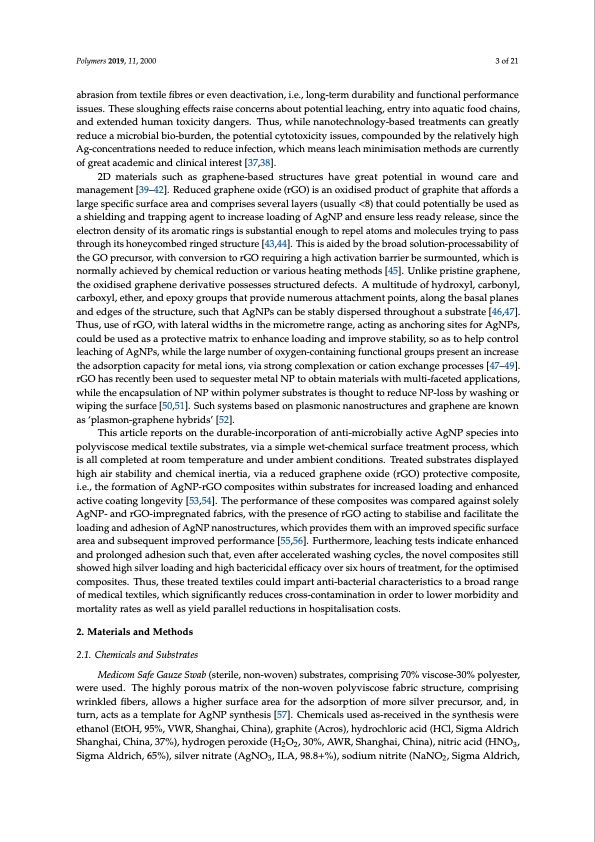
PDF Publication Title:
Text from PDF Page: 003
Polymers 2019, 11, 2000 3 of 21 abrasion from textile fibres or even deactivation, i.e., long-term durability and functional performance issues. These sloughing effects raise concerns about potential leaching, entry into aquatic food chains, and extended human toxicity dangers. Thus, while nanotechnology-based treatments can greatly reduce a microbial bio-burden, the potential cytotoxicity issues, compounded by the relatively high Ag-concentrations needed to reduce infection, which means leach minimisation methods are currently of great academic and clinical interest [37,38]. 2D materials such as graphene-based structures have great potential in wound care and management [39–42]. Reduced graphene oxide (rGO) is an oxidised product of graphite that affords a large specific surface area and comprises several layers (usually <8) that could potentially be used as a shielding and trapping agent to increase loading of AgNP and ensure less ready release, since the electron density of its aromatic rings is substantial enough to repel atoms and molecules trying to pass through its honeycombed ringed structure [43,44]. This is aided by the broad solution-processability of the GO precursor, with conversion to rGO requiring a high activation barrier be surmounted, which is normally achieved by chemical reduction or various heating methods [45]. Unlike pristine graphene, the oxidised graphene derivative possesses structured defects. A multitude of hydroxyl, carbonyl, carboxyl, ether, and epoxy groups that provide numerous attachment points, along the basal planes and edges of the structure, such that AgNPs can be stably dispersed throughout a substrate [46,47]. Thus, use of rGO, with lateral widths in the micrometre range, acting as anchoring sites for AgNPs, could be used as a protective matrix to enhance loading and improve stability, so as to help control leaching of AgNPs, while the large number of oxygen-containing functional groups present an increase the adsorption capacity for metal ions, via strong complexation or cation exchange processes [47–49]. rGO has recently been used to sequester metal NP to obtain materials with multi-faceted applications, while the encapsulation of NP within polymer substrates is thought to reduce NP-loss by washing or wiping the surface [50,51]. Such systems based on plasmonic nanostructures and graphene are known as ‘plasmon-graphene hybrids’ [52]. This article reports on the durable-incorporation of anti-microbially active AgNP species into polyviscose medical textile substrates, via a simple wet-chemical surface treatment process, which is all completed at room temperature and under ambient conditions. Treated substrates displayed high air stability and chemical inertia, via a reduced graphene oxide (rGO) protective composite, i.e., the formation of AgNP-rGO composites within substrates for increased loading and enhanced active coating longevity [53,54]. The performance of these composites was compared against solely AgNP- and rGO-impregnated fabrics, with the presence of rGO acting to stabilise and facilitate the loading and adhesion of AgNP nanostructures, which provides them with an improved specific surface area and subsequent improved performance [55,56]. Furthermore, leaching tests indicate enhanced and prolonged adhesion such that, even after accelerated washing cycles, the novel composites still showed high silver loading and high bactericidal efficacy over six hours of treatment, for the optimised composites. Thus, these treated textiles could impart anti-bacterial characteristics to a broad range of medical textiles, which significantly reduces cross-contamination in order to lower morbidity and mortality rates as well as yield parallel reductions in hospitalisation costs. 2. Materials and Methods 2.1. Chemicals and Substrates Medicom Safe Gauze Swab (sterile, non-woven) substrates, comprising 70% viscose-30% polyester, were used. The highly porous matrix of the non-woven polyviscose fabric structure, comprising wrinkled fibers, allows a higher surface area for the adsorption of more silver precursor, and, in turn, acts as a template for AgNP synthesis [57]. Chemicals used as-received in the synthesis were ethanol (EtOH, 95%, VWR, Shanghai, China), graphite (Acros), hydrochloric acid (HCl, Sigma Aldrich Shanghai, China, 37%), hydrogen peroxide (H2O2, 30%, AWR, Shanghai, China), nitric acid (HNO3, Sigma Aldrich, 65%), silver nitrate (AgNO3, ILA, 98.8+%), sodium nitrite (NaNO2, Sigma Aldrich,PDF Image | Antimicrobial from Silver-Graphene Coated Medical Textiles

PDF Search Title:
Antimicrobial from Silver-Graphene Coated Medical TextilesOriginal File Name Searched:
polymers-11-02000-v2.pdfDIY PDF Search: Google It | Yahoo | Bing
Turbine and System Plans CAD CAM: Special for this month, any plans are $10,000 for complete Cad/Cam blueprints. License is for one build. Try before you buy a production license. More Info
Waste Heat Power Technology: Organic Rankine Cycle uses waste heat to make electricity, shaft horsepower and cooling. More Info
All Turbine and System Products: Infinity Turbine ORD systems, turbine generator sets, build plans and more to use your waste heat from 30C to 100C. More Info
CO2 Phase Change Demonstrator: CO2 goes supercritical at 30 C. This is a experimental platform which you can use to demonstrate phase change with low heat. Includes integration area for small CO2 turbine, static generator, and more. This can also be used for a GTL Gas to Liquids experimental platform. More Info
Introducing the Infinity Turbine Products Infinity Turbine develops and builds systems for making power from waste heat. It also is working on innovative strategies for storing, making, and deploying energy. More Info
Need Strategy? Use our Consulting and analyst services Infinity Turbine LLC is pleased to announce its consulting and analyst services. We have worked in the renewable energy industry as a researcher, developing sales and markets, along with may inventions and innovations. More Info
Made in USA with Global Energy Millennial Web Engine These pages were made with the Global Energy Web PDF Engine using Filemaker (Claris) software.
Infinity Turbine Developing Spinning Disc Reactor SDR or Spinning Disc Reactors reduce processing time for liquid production of Silver Nanoparticles.
| CONTACT TEL: 608-238-6001 Email: greg@infinityturbine.com | RSS | AMP |